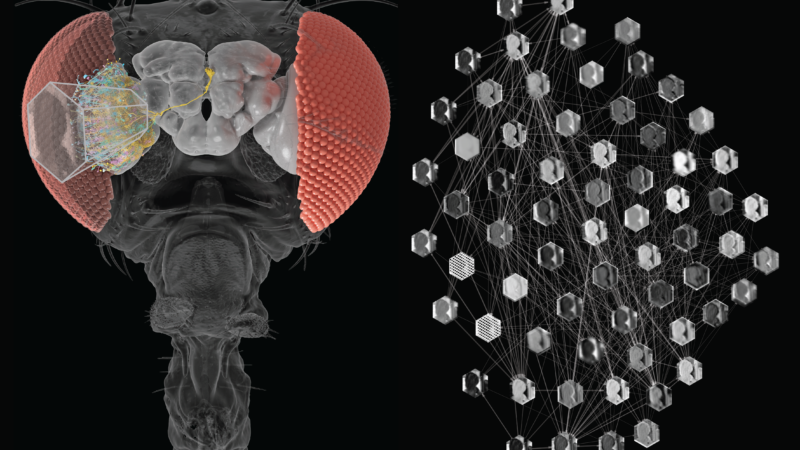AI met fruit fly, and a better brain model emerged
Scientists have created a virtual brain network that can predict the behavior of individual neurons in a living brain.
The model is based on a fruit fly’s visual system, and it offers scientists a way to quickly test ideas on a computer before investing weeks or months in experiments involving actual flies or other lab animals.
“Now we can start with a guess for how the fly brain might work before anyone has to make an experimental measurement,” says Srini Turaga, a group leader at the Janelia Research Campus, a part of the Howard Hughes Medical Institute (HHMI).
The approach, described in the journal Nature, also suggests that power-hungry artificial intelligence systems like ChatGPT might consume much less energy if they used some of the computational strategies found in a living brain.
A fruit fly brain is “small and energy efficient,” says Jakob Macke, a professor at the University of Tübingen and an author of the study. “It’s able to do so many computations. It’s able to fly, it’s able to walk, it’s able to detect predators, it’s able to mate, it’s able to survive—using just 100,000 neurons.”
In contrast, AI systems typically require computers with tens of billions of transistors. Worldwide, these systems consume as much power as a small country.
“When we think about AI right now, the leading charge is to make these systems more power efficient,” says Ben Crowley, a computational neuroscientist at Cold Spring Harbor Laboratory who was not involved in the study.
Borrowing strategies from the fruit fly brain might be one way to make that happen, he says.
A model based on biology
The virtual brain network was made possible by more than a decade of intense research on the composition and structure of the fruit fly brain.
Much of this work was done, or funded, by HHMI, which now has maps that show every neuron and every connection in the insect’s brain.
Turaga, Macke and PhD candidate Janne Lappalainen were part of a team that thought they could use these maps to create a computer model that would behave much like the fruit fly’s visual system. This system accounts for most of the animal’s brain.
The team started with the fly’s connectome, a detailed map of the connections between neurons.
“That tells you how information could flow from A to B,” Macke says. “But it doesn’t tell you which [route] is actually taken by the system.”
Scientists have been able to catch glimpses of the process in the brains of living fruit flies but they have no way to capture the activity of thousands of neurons responding to signals in real time.
“Brains are so complex that I think the only way we will ever be able to understand them is by building accurate models,” Macke says.
In other words, by simulating a brain, or part of a brain, on a computer.
So the team decided to create a model of the brain circuits that allow a fruit fly to detect motion, like the approach of a fast moving hand or fly swatter.
“Our goal was not to build the world’s best motion detector, but to find the one that does it the way the fly does.”
The team started with virtual versions of 64 types of neurons, all connected the same way they would be in a fly’s visual system. Then the network “watched” video clips depicting various types of motion.
Finally, an artificial intelligence system was asked to study the activity of neurons as the video clips played.
Ultimately, the approach yielded a model that could predict how every neuron in the artificial network would respond to a particular video. Remarkably, the model also predicted the response of neurons in actual fruit flies that had seen the same videos in earlier studies.
A tool for brain science and AI
Although the paper describing the model has just come out, the model itself has been available for more than a year. Brain scientists have taken note.
“I’m using this model in my own work,” says Cowley, whose lab studies how the brain responds to external stimuli. He says the model has helped him gauge whether ideas are worth testing in an animal.
Future versions of the model are expected to extend beyond the visual system and to include tasks beyond detecting motion.
“We now have a plan for how to build whole-brain models of brains that do interesting computations,” Macke says.
Transcript:
JUANA SUMMERS, BYLINE: Scientists have created an artificial intelligence system that thinks like a fruit fly, and that’s a good thing. NPR’s Jon Hamilton reports that the approach could help make some technologies more efficient and provide new insights into how the brain processes information.
SUMMERS: Scientists have created an artificial intelligence system that thinks like a fruit fly, and that’s a good thing. NPR’s Jon Hamilton reports that the approach could help make some technologies more efficient and provide new insights into how the brain processes information.
JON HAMILTON, BYLINE: The latest artificial intelligence systems can drive a car and even write fiction, but they rely on computers that contain billions of transistors and consume lots of electricity. Jakob Macke at the University of Tubingen says a fruit fly gets by with a lot less processing power.
JAKOB MACKE: And yet, with a small and energy-efficient brain, it’s able to do so many computations. It’s able to fly. It’s able to walk. It’s able to detect predators. It’s able to mate. It’s able to survive using just 100,000 neurons.
HAMILTON: Macke and a team of scientists wanted to know how a fruit fly does so much with so little, so they reviewed recent studies that have identified all the neurons in an insect’s brain, as well as all the connections between those neurons. These pathways are known collectively as a connectome, and Macke says it gave the team a sort of road map.
MACKE: It tells you who’s connected to who and how big is each road. That, in principle, tells you how information could flow, how you could travel from A to B, but it doesn’t tell you which of these travels are actually taken by the system.
HAMILTON: And Macke says there’s no good way to see all the information traveling through a living brain, even one as simple as a fruit fly’s.
MACKE: Brains are so complex that I think the only way we will ever be able to understand them is by building accurate models.
HAMILTON: In other words, by simulating a brain or part of a brain on a computer. So that’s what the team did. Srini Turaga is from the Howard Hughes Medical Institute’s Janelia Research Campus in Virginia. He says they focused on brain circuits that allow a fruit fly to detect motion.
SRINI TURAGA: Our goal was not to build the world’s best motion detector, but to find the one that does it the way the fly does.
HAMILTON: The team created a computer model based on the connectome of a fruit fly’s visual system. Then they had an artificial intelligence system watch movies known to trigger a motion response in the brain of a living fruit fly. Eventually, the machine got really good at detecting movement, and tests showed that it was doing this the same way an actual fruit fly does. Turaga says that finding has big implications for brain scientists.
TURAGA: If you know the connectome and you know something about what the circuit is supposed to do, what it’s supposed to compute, we can use AI to then predict neural activity for every single neuron.
HAMILTON: Because the model behaves just like a real fly brain. The research appears in the journal Nature, and Turaga says it should accelerate efforts to understand how brains process information in all areas, not just the visual system.
TURAGA: Now we can start with a guess for how the fly brain might work before anyone has to make an experimental measurement.
HAMILTON: Ben Cowley is a computational neuroscientist at Cold Spring Harbor who was not involved in the research, but he’s already a convert.
BEN COWLEY: I’m using this model in my own work because it beautifully makes some predictions about this is what we should expect to see if one were to record from these neurons.
HAMILTON: And it shows how living brains are able to make so many calculations without consuming much energy. Cowley says that’s one of the big challenges in the field of artificial intelligence.
COWLEY: When we think about AI, right now, I think the leading charge is to make these systems more power efficient.
HAMILTON: By doing a lot with a little, much like a fruit fly. Jon Hamilton, NPR News.
(SOUNDBITE OF MUSIC)
GPB evening headlines for September 18, 2024
Prosecutors have dropped some charges against three people indicted in connection with Atlanta police training center protests. The two candidates for district attorney in Savannah's Chatham County clashed over experiences and records in a forum this week. Georgia's Supreme Court is rejecting an effort to force new Republican primary elections in northwest Georgia's Catoosa County.
Forget tedious paper applications, Americans can now renew passports online
The State Department announced Wednesday that its online renewal system is now fully operational, after testing in pilot programs, and available to adult passport holders whose passport had expired within the past five years or will expire in the coming year.
Vance says Haitian migrants with protected status are ‘illegal aliens’ to be deported
The Republican vice presidential nominee continues to rail against Haitian migrants living in Ohio, though many have Temporary Protected Status, as the GOP escalates its hardline immigration stance.
The latest on the Land Back movement, in which Native American tribes reclaim land
The Land Back Movement is an effort by native Americans to reclaim lost land. Two reporters take a look at where it’s worked and where it hasn’t at reservations in Minnesota.
What the upcoming election looks like for Georgia GOP chairman Josh McKoon
NPR's Mary Louise Kelly talks with Georgia Republican Party chair Josh McKoon in Atlanta ahead of the 2024 presidential election.
Congress votes down spending bill as government shutdown looms
Congress is running out of time to avert a government shutdown. House Republicans will put up a partisan proposal that does not even have enough votes within their own party.



